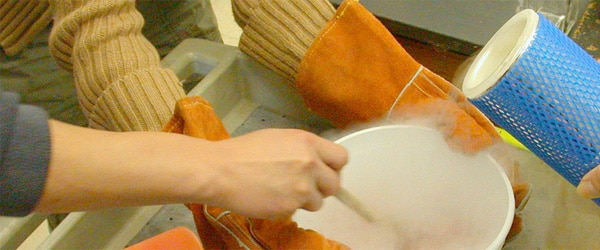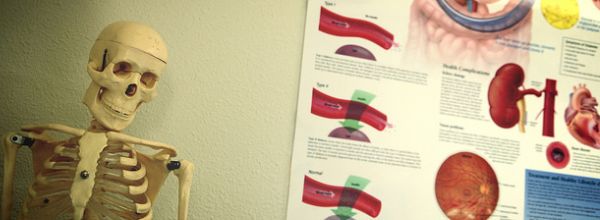Pipetting all day? Scrolling and scrolling through Excel columns trying to make sense of your data? Spending hours at the microscope because your boss wants Nature-worthy pictures?
It’s not uncommon that performing lab work forces you into unhealthy postures, and after a day at work your spine begs for mercy.
How Your Posture Suffers on an Average Day in the Lab
Take, as an example, the posture you have when the height of the chair and of the table are not proportioned with your height. If you’re using a microscope, chances are your hips are going forward, your upper back is pushing backwards, and your head and neck are pulling forward to the binoculars.
Things are even worse when you’re pipetting. You’ll use your dominant hand to do most of the job. This means that only one part/side of your body will be contracted, while the other is resting. So, in addition of what was said few lines above about the curves of your back, you’ll tend to have one shoulder higher than the other, due to the constant and unbalanced contraction of the trapezoids and of the deltoids.
What can you do about it? There are some simple life hacks that will help you avoid going home with your back looking like it was designed by Picasso. I’m going to list the most useful and easy-to-follow ones for you.
Let’s Start with Good Posture: The Wire Position.
Imagine that a thin wire is attached to the top of your head. It is really thin and delicate and it’s pulling you upwards to the ceiling. If you bend forward or you lean on the sides, the wire will stretch too much and break.
To nail this posture position, you have to try to stand upright as much as you can, imagining of that you are reducing the tension of the wire. Your shoulders will naturally go a bit down and backwards, while your chest goes slightly forward.
Working at aligning your spine will not only save your back from stress, but you will also be able to breath better by opening up your chest and lungs. Plus, you will look less slumped.
Unfortunately, sometimes keeping this healthy position is not possible because of the task you’re performing. In those instances, you’ll have to take corrective actions as soon as you can. Keep reading to discover what can easily be done in your breaks.
Pain in Your Neck and Shoulders? The Bubble Head.
Every time you’re at the coffee machine, while you get ready to pour yourself a mug of that invigorating nectar, get yourself set up in the wire position and then stretch your neck one side at the time. Slowly lower your right ear towards your right shoulder (without lifting your left shoulder) and hold for a couple of seconds; repeat the same on the left side.
Modified version: from the wire position, slowly turn only your head from side to side as far as you can go without moving your shoulders. Do this exercise a couple of times, keeping the position of maximum tension for one or two seconds.
Not only will this stretching exercise make it easier to see if your boss is behind you, but you’ll also cut some extra calories if you repeat it every time a colleague offers you donuts or cookies.
Pain in the Upper Part of the Back, Around the Shoulder Blades? The Cactus.
You can do this exercise two or three times per day, when you enter your office or when you go to the bathroom.
- Begin in the wire position, remembering to extend yourself from the heels to the top of your head.
- Extend your arms in front of you, palms up.
- Touch your forearms and elbows together in front of your chest and raise them your elbows are at the same height as your shoulders.
- Bend your elbows so that there’s a 90 degree angle between your upper arms and forearms. Your forearms and hands will be pointing upwards.
- Close your fists and open your arms from the center to your sides, describing a quarter of a circle with your elbows.
- The elbows have to stay at the same height of your shoulders and your hands pointing upwards all the time.
- Voilà! You look like a cactus.
- Go back to the starting position and repeat a couple of times.
Alternative: Take the cactus position up to point 4. Move your arms backwards from your sides, trying to shorten the space between the shoulder blades. Rest two seconds and repeat. The movement is shorter, but the effect is guaranteed.
Want to do more? Do this exercises at home with some light dumbbells or water bottles! Done regularly, it’ll strengthen your back muscles and help keep your back straight without too much effort.
Pain in Your Lower Back? The Desk-Chair Sandwich.
When you bend over a microscope or a keyboard for hours you’re likely to have pain in the lower part of your back. Especially if your buttocks slowly slide down the chair.
This happens because the tendons of the lumbar muscles get easily inflamed when overstretched for long periods of time.
The best solution would be buying a yoga mat and doing some crunches at home. Five minutes are enough! However, if that just isn’t in the cards, I have another trick for you:
Sit with your back straight, and move your chair forward so that your belly is pressed against the desk and your back is supported by the backrest of the chair.
In this position you’re likely to stay erect without muscular effort.
To keep this position as ergonomic as possible, be sure to adjust the height of your chair and your monitors – this will likely change depending on the task you are performing.
Never Give up on Good Posture
Don’t be afraid of being creative. During my master thesis internship, I had to measure tissue sections at the microscope all day.
Table, chair and microscope were not customizable, so I simply took a huge textbook, the size of a big dictionary, and put it under the microscope, so that I could keep working with my back and neck straight as in the wire position, and my arms naturally relaxed on the table. I could also have put pillows on the chair, but the book was easier to find.
Unfortunately, these adjustments are not always possible, especially when working with big instruments. Still, more often than not, your employer is most likely obliged to provide ergonomic tables and chairs. So don’t be afraid to ask!
Hopefully you’ll avoid lab aches by doing these exercises regularly. Make them part of your day to day routine so you can do them without thinking about it.
Be proactive, don’t wait until you are in pain!






